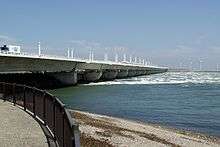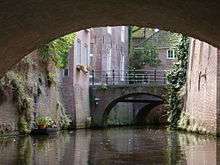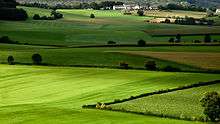Southern Netherlands
The Southern Netherlands is a region quite unlike the rest of the country. Especially Limburg and North-Brabant are distinct for their historic background, Catholic culture and, in the very south, even the rolling landscape - quite unlike any Dutch stereotype. And then there's Zeeland, the province at the heart of the Dutch efforts to tame the sea. Historically one with the northern provinces, this sea side region has a culture of its own and is famously home to the impressive Delta Works.
Regions
| Limburg (North Limburg, South Limburg) Unlike the rest of the country, the south of Limburg is a hilly territory. Explore the beautiful city of Maastricht and experience the wonderful mix of cultures. |
| North Brabant Originally a Catholic bastion of the Netherlands with cozy historic towns, also known for its industry and the historic cities of Breda and 's-Hertogenbosch or the well-preserved 'cities' (fortifications) of Heusden and Willemstad. |
| Zeeland Sea and beach resorts, with the Delta Works as a monument of the Dutch struggle against the water. Also visit the old city of Middelburg. |
Cities
- 🌍 Breda is a former military bulwark, Breda still has an historical center and military and industrial sights are (being) redeveloped.
- 🌍 Eindhoven , a city which gained its status due to the technology concern Philips. Is known for modern design, vibrant nightlife and, of course, technology.
- 🌍 's-Hertogenbosch , the capital of Noord-Brabant, a well-preserved city known for Bossche Bollen (Chocolate balls) and St. John's Cathedral.
- 🌍 Maastricht , being one of the oldest cities in the Netherlands, Maastricht is undoubtly worth a visit with its cultural mix and foothills of the Ardennen (Ardennes).
- 🌍 Middelburg is a restful university city being the capital of Zeeland. The historical centre is well-preserved.
- 🌍 Roermond , a Limburgian town, dominated by the Munsterkerk (minster) and the Meuse. Its history was one of battles, while many buildings survived and form a monumental centre.
- 🌍 Tilburg , once the 'wool capital' of the Netherlands, Tilburg isn't quite historically because of much 1960s urban renewal, however, some monumental buildings, such as King William II's palace, still survive.
- 🌍 Venlo is known for being a place visited by many Germans, however, the historical town centre is somewhat less than e.g. Roermond, it can't be ignored on transit to Germany.
- 🌍 Vlissingen was once the most important harbour for international trade in the Netherlands, and still has an important naval function. Vlissingen (sometimes called Flushing in English) is also the birthplace of Michiel de Ruyter, the most famous admiral in Dutch history.
Other destinations

- 🌍 Biesbosch National Park — one of the last freshwater tide areas in Europe
- 🌍 Delta Works — the enormous storm surge barriers that finally ended the country's struggle against the sea
- 🌍 Efteling — theme park with fantasy elements like elves and dwarves
- South Limburg — hilly green landscapes, picturesque villages, castles and orchards
Understand
Catholicism
The southern provinces have historically been the Roman Catholic area of the Netherlands, in contrast with Protestantism in the north of the country. That's still well visible in the architecture of churches and cathedrals, as well as in city centers. Nowadays, Catholicism is still the predominant religion in Limburg (where over 75% of people call themselves Catholic) and Brabant (just over half). It's said that the Catholic way of life brings a more bourgondic lifestyle to these provinces, especially in Limburg.
Try not to refer to the country as "Holland" here, as people from the south live in the Netherlands, and Holland is a synonym for the more northern and western parts.
Carnival
In Brabant and Limburg, Carnaval is celebrated widespread. The locals will either call it kèrneval (Brabant) or vasteloavend (Limburg) and mostly in Brabant, settlement names are changed into a funny name, such as Oeteldonk (Den Bosch) or Lampegat (Eindhoven). In Limburg, the Limburgish language names of the settlements only will be more visible, such as Remunj (Roermond).
In the last days before the end of the season on Aswoensdag, Ash Wednesday, many streets are decorated, and colours may depend on the street, neighbourhood, village or city. There also will be parades and people go to cafés in the late evening. Don't be surprised if shops are closed in these provinces on the last two days before ash Wednesday.
Talk
Although many people in the Southern Netherlands speak a regional or local dialect as their mother tongue, virtually everyone speaks Dutch and many people speak English and/or German too. You will however find a few distinctive language characteristics compared to Standard Dutch. Most notable are the use of a soft G, sounding like the German 'ch', and the general use of a guttural R. Especially for non-native speakers, this often strong accent can make Dutch harder to understand around here. Nonetheless, you're very unlikely to encounter any serious trouble in communicating.
A wide range of local and regional dialects are spoken throughout the region, although only Limburgisch has an official status. In some areas you'll find that e.g. street or town name signs are indicated both in Dutch and the local dialect.
Get in
By car
The Southern Netherlands are accessible greatly from surrounding regions. The A12, A1, A40, A2 and A25 from Belgium might be good options, as well as the German Autobahns 4, 61 and 40. From the northern side, the A29, A16, A27, A2, A50 and A73 form the main options. Keep in mind that especially the northern roads can get very crowded during rush hours, and traffic congestion is an everyday problem in the mornings and afternoons. There are typically no border controls or other hold ups when entering the Netherlands by road.
By plane
Amsterdam Airport Schiphol is an obvious option for many tourists to reach this region, but especially when you're heading to Limburg, airports across the Belgium and German border offer interesting alternatives.
Eindhoven Airport is a smaller but fast-growing airport, offering many international links in Europe and budget carriers. Otherwise, Maastricht-Aachen Airport in the south of the Netherlands is a good option too. A bit further away, Düsseldorf Airport in Germany and Zaventem Airport in Brussels (Belgium) are major airports and offer ample international services. For budget carriers, try Dusseldorf Airport Weeze in Germany or Airport Charleroi in Belgium.
By train
From as well as Utrecht and Rotterdam, the first train stations, Breda and 's-Hertogenbosch are accessible four times an hour by intercity. Otherwise, multiple stopping trains go to the region. 1x per hour from Antwerp to Roosendaal, 2-4x per hour from Nijmegen to Brabant and Limburg, 1x per hour from Düsseldorf and Mönchengladbach to Venlo, 1x per hour from Aachen to Heerlen and 1x per hour from Liège to Maastricht.
From April 8, 2013, every two hours there is fast link (Fyra) between Antwerp and Breda.
Get around
All parts of the region are well connected by road, with many border crossings to Germany and Belgium and descent roads to even the smallest of hamlets. A car is therefore an excellent way to get around, allowing also for easy exploration of countryside sights and landscapes. Car rental companies are available from all large cities, local airports as well as in large tourist areas such as Valkenburg. When in doubt, ask the tourist office.
The region isn't too huge and except for the rolling hills of South-Limburg, the Southern Netherlands' terrain allows for easy cycling. Bike lanes and scenic bike and hike routes are available all around. The main bike route from one town to the next is typically indicated with red and white road signs, along with the car route indications.
The public transport network is extensive, and although buses and trains in the Netherlands are generally not cheap, they do allow for travellers to get around easily. Make sure to buy an OV-chipcard, as that can be used on all buses and trains. Trains only serve larger and mid-sized destinations. The main intercity routes and some regional trains are operated by NS, while some others are operated by Veolia. Buses are operated by Veolia and Connexxion and serve pretty much every village around. Note however that especially more remote or small places are served less frequently (typically once per hour) and buses there don't run after 10pm or so.
See


The Southern Netherlands are, in general, a bit less about the clogs, tulips and windmill clichés than the west. If it's stereotypes you're after, however, there are plenty to be discovered. You'll find typical polder landscapes in the western parts and although not picture-perfectly lined up like the ones at Kinderdijk, windmills are available all around. Almost 300 operational mills remain in the region and, due to the less flat terrain, watermills are more common than in any other part of the country. The mighty Delta Works have become a world wide symbol of the Dutch efforts to tame the sea. This engineering project finally ended the Dutch' centuries' long struggle against the water in the highly populated south-west. It consists of multiple storm barriers at different locations, but the most accessible one (with a visitor's centre) is the Oosterscheldekering at the Deltapark Neeltje Jans. For a taste of Dutch maritime life, spend some time in the once prominent harbours of Vlissingen and Middelburg, or follow the crowds to small but pleasant Sluis.
However, to see the best of this region, don't stop looking there. Make your way to the lush, rolling hills of South Limburg, a popular holiday destination for the Dutch but overlooked by the international crowds. Follow the Mergellandroute, a road-route leading along some of the best landscapes and timber-framed houses in the area. This is also an area heavy on castles, many well-restored and some open to the public. Kasteel Hoensbroek is a good choice as it is now a museum, Sjaloen in Valkenburg and Neercanne in Maastricht (now a restaurant) are other famous examples. The pretty castle gardens in Arcen are another fine pick.
While you're there, don't miss out on a day in the historic city centre of Maastricht, one of the most beautiful cities in the country and second only to Amsterdam when it comes to the number of monuments. Another fabulous city to visit is 's Hertogenbosch, which has a lovely medieval old town and a maze of canals under the city. For a more modernist experience, head to bustling Eindhoven, called the light city for its industrial history and widely known as the Dutch capital of design. If you're into modern art, make sure to visit the excellent collection of the Van Abbe museum here.
Lastly, the Southern Netherlands are home to some fine natural areas and parks. The Biesbosch National Park is a popular destination for the Dutch and one of the last freshwater tide areas in Europa. It is characterized by a network of large and small creeks and best explored by boat. If you like scuba-diving, try the Oosterschelde Nationaal park. Its salty waters are filled with sea life, including some unique regional species. The almost un-Dutch sand dunes and extensive heath lands of the Loonse en Drunense Duinen are surrounded by towns and get crowded on summer days, as it's a perfect day trip from any of those places.
Do
- Dress up and join the massive carnival celebrations that take over life in large parts of this region early in spring. It only lasts a few days, but for many people it's a highlight of the year. Watch a parade, catch some candies that the "princes" throw out and dance in the streets.
- Go canoeing. Whether it's in the Biesbosch National Park, the Maasplassen around Roermond or on the river Meuse near Maastricht, it's a great pass time and a fun way to discover the surroundings, even for beginners. If you're less adventurous, hop on a sightseeing boat in the same areas. Of course, other water sports are available too.
- Hiking and biking are highly popular. The several natural parks make for fine natural tours, but the countryside has some fine routes too, combining nice landscapes with heritage and charming villages. Where-ever you are, the local tourist information office will have all kinds of routes available, and almost everywhere you'll find there are indicated trails to be followed.
- Shop till you drop in modern Eindhoven, historic 's Hertogenbosch or Maastricht, or at the huge outlet centre of Roermond. The Southern Netherlands has plenty of shopping opportunities and, combined with the charming town centres, they make for fine days out.
Eat
There's no such thing as Southern Dutch cuisine, as the different parts of this region all have their own historic traditions and local produce. In Zeeland, obviously oriented on the sea, fish and sea fruits are a major part of traditional cuisine. Zeeuwese mussels are available all through the country in season, and the Oosterschelde, an estuary and national maritime park, is famous for the high quality lobster that is caught there. However, there's more than fish, as Zeeuws spek, a slow-cooked and seasoned bacon, has become popular throughout the Netherlands. On the sweet side, Zeeland is known for the Zeeuwse bolus or jikkemine, a sweet pastry of Jewish origin, as well as for regional butterscotch candies. Such sweet treats are popular tourist souvenirs.
On the other end of the region, Limburg has quite different culinary specialities, and advocates its large number of "regional products and dishes". In spring, green and white asparagus from Limburgian soil make their way to restaurant menus all over the Netherlands. There are clear influences of German and French cuisine, as the Limburg history is intertwined with both those countries. In the south, try zuurvlees, a specific kind of sweet and sour stew, a bit like some German kinds of "sauerbraten" but originally prepared with horse meat. Tête de veaux is another typical Limburgian stew, but this one has French influence and is made of veal and mushrooms in a tomato sauce. There are typical, regional kinds of salad olivier called koude schotel in Limburg and huzarensalade (which are different in taste) in Noord-Brabant. Head cheese is mostly a Limburgian thing, and although a peasant dish in origin, it is now rather a delicacy. Noord Brabant then again is known for its sausage rolls.
Travelling in Limburg, there will be no avoiding the regional sweet pastry: Limburgse vlaai, a pie or tart with a fruit or custard filling, typically eaten as a sweet treat with coffee or tea. Noord-Brabant's most famous sweet dish is the Bossche bol, a local 's Hertogenbosch pastry rather than a regional one.
Drink
The southern part of the Netherlands (in particular Brabant and Limburg) is best known for its beers, as a good number of the country's prime beer brands are produced here. The most notable examples are Brand, Gulpener and Hertog Jan from Limburg, Dommelsch and Bavaria from Brabant. The only Dutch trappist beer comes from Tilburg (also in Brabant).
When thinking of wine, few people will have the Netherlands in mind. However, over the past decades wine orchards have popped up all over the Netherlands. This is especially true for the south, where wine making first started in Roman times, and where this tradition was rediscovered and brought back to life in the 1970s. Still today, no other Dutch region has as many vineyards as the Southern Netherlands, with the largest production volumes originating in the rolling hills of South Limburg. Both in terms of quantity and quality, Dutch wines can't really compare to the massive and century old traditions of nearby Germany or France, but international tests are showing a steady increase in quality and some rather good examples. Apart from taste, the vineyards of course add to the charm of the landscapes, especially in the South.
In Zeeland, when you order apple juice, you've got a big chance you will get so-called Appelaere, which is a brand name from a company that offers a turbid apple-drink from local Zeelandic apple orchards.
Go next
Of course it's a short drive to all the major tourist attractions in the Western Netherlands. However, from anywhere in the Southern Netherlands you're a short tour away from great destinations in neighbouring Belgium and Germany. This is a typical example of the open European borders leading to an almost internationally oriented border region, with people living, working and shopping in neighbouring countries. Road and public transport connections are typically good.
From Breda, it's a 45 minute drive to historic Antwerp. Or, head to Gent or magnificent Bruges (1h and 1.5h respectively from Vlissingen and Middelburg). In the very south, the tripoint in Vaals marks the place where the borders of the three countries meet at one point. This area is often called the Euregio. From here, you'll get to fine destinations like Cologne or Liege in just about an hour.